Lourdes United
-
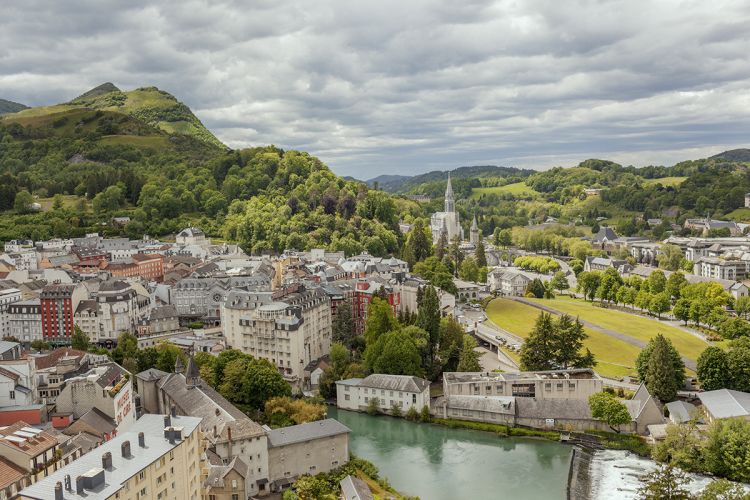

Panoramic view of Lourdes from the Château overlooking the hotel complex and the Sanctuary. These are the three main actors of the Marian city concerned by the “Lourdes, horizon 2030”, the long awaited recovery plan for Lourdes, included in measure 21 decided by the State. Within this plan, the Occitania region joins the State and invests up to 20 million euros to carry out the renewal of the Marian city at various levels. Although these measures will provide for the urgent needs of part of the population of the Marian city, as well as its local merchants and hoteliers, the objective remains a long-term aid and a real renewal of the image of Lourdes. Second in popularity to Rome for Catholics, France’s most famous pilgrimage site took lessons from the loss in visitors from pandemic restrictions by broadening its digital outreach. The city has created a plan to develop other attractions to make its tourism industry more sustainable.
-
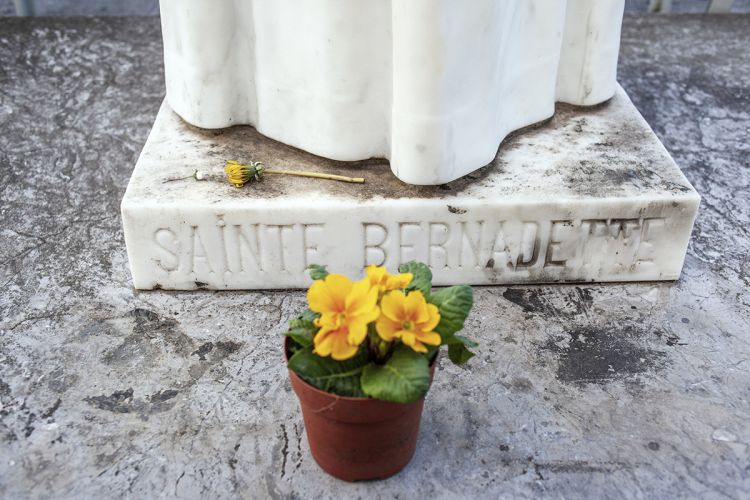

Statue of Saint Bernadette in the Shrine. I couldn’t think of a better background to tell this story: Bernadette Soubirou, the young French shepherdess who witnessed eighteen Marian apparitions in the grotto of Massabielle between 11 February and 16 July 1858, became a nun, until her canonisation in 1933, is is my great grand cousin to the fifth degree. However, I grew up in a non-practicing, rather atheistic family, and rediscovering Lourdes from this perspective raises many questions for me related to spirituality.
-
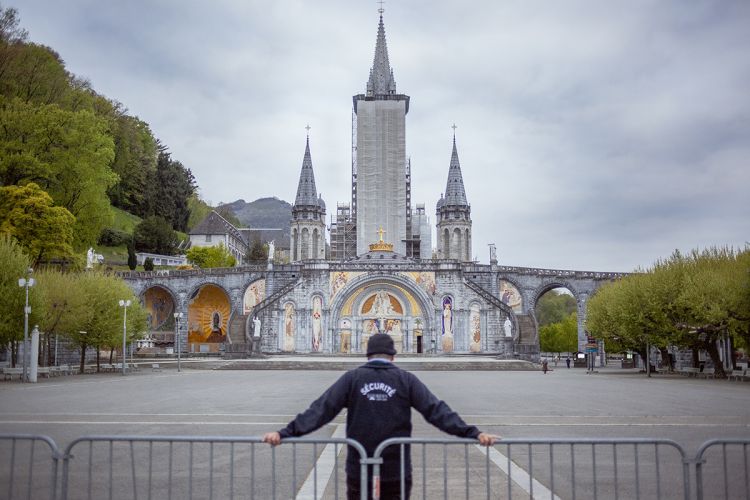

The deserted esplanade of the Basilica of Our Lady of the Rosary at the Shrine of Lourdes during Holy Week. The Sanctuary has published a widely distributed “charte sanitaire” for pilgrims and visitors, which includes information on anti-Covid security measures, routes to follow, rules to be observed and indications on how to use the sanctuary’s services and ensure a safe return to his followers.
-
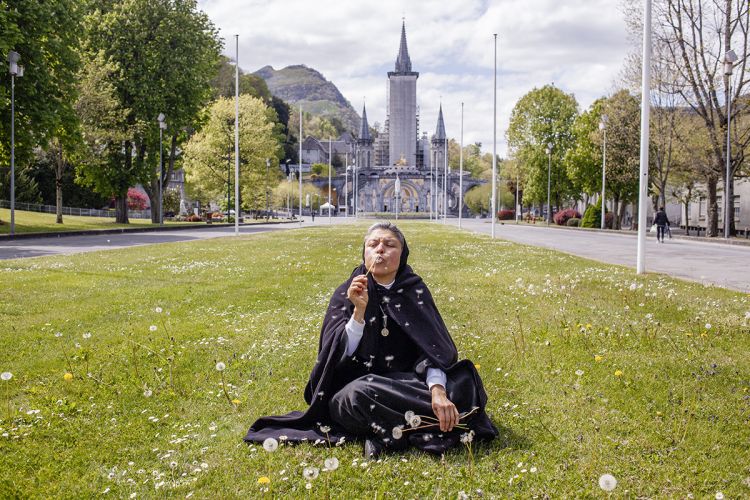

Sister Cecilia blows a dandelion flower in front of the Sanctuary of Our Lady of Lourdes. For her, Lourdes´s message is very topical. Lourdes is a place where vulnerability is not an obstacle but an asset. We live in a time in which people are asking themselves the question of “meaning”. The crisis highlighted several issues and we need answers. We are confronted with the question of uncertainty. Our society is based on the ideology of progress and we rely on science to help us improve. A “small” virus jeopardised our projections beyond one week. It is to this uncertainty that faith responds.
-
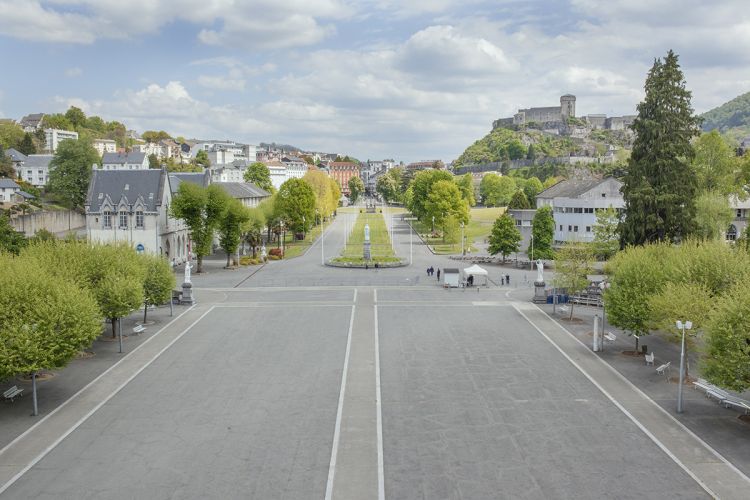

The Shrine in figures:
2019 3.5 millions pilgrims
2020 800,000 thousand pilgrims
2020 90% of pilgrimages have been cancelled.
The Shrine’s economy is based mainly on donations, quests, offerings, purchases of candles, prayer intentions and the reception of sick pilgrims. These sources of income are at a standstill. However, in order to be able to ensure the return of its elders, the shrine will have to make costly renovations. In 2021, the de cit of the sanctuary is estimated at 5 million euros. -
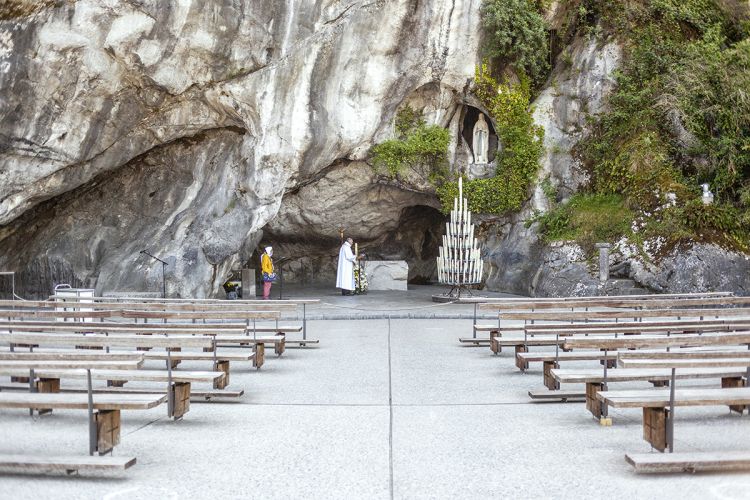

After the closure of the sanctuary in March 2020, the rector decided to make the sanctuary “a lung of prayer at the heart of a suffering world” with an unceasing prayer from morning till night.
Celebration of the rosary at 1am. broadcasted live by Father Mauricio Elias, coordinator of the Spanish language at the Shrine since June 2020. He is accompanied by a volunteer, a resident of the city. “As a Catholic, not only in Lourdes but in many places, you have to understand the meaning of what you are doing.” With the pandemic, one becomes aware that the gestures at Lourdes, all involving physical touch, have to be rethought according to the sanitary conditions, returning to the original message of the Virgin to Saint Bernadette and to the spiritual meaning of Lourdes.
According to Father Maurice, the interpretation of the world is to “do as we please”, to live a false freedom and the current context allows us all to rethink our ways of living and religion its way of functioning. -
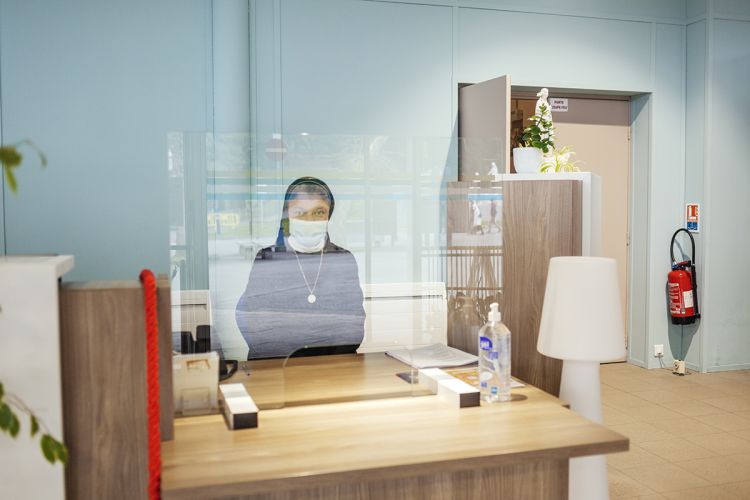

Sister Cecilia works full time in the Information centre of the shrine. As a nun, her mission is to welcome and “to find a brother or sister in each pilgrim who comes to the shrine”. Aware that the profile of pilgrims is changing with the pandemic, she welcomes each visitor with fervour. She currently spends a lot of time answering calls, generally asking whether the shrine is open or not. She underlines the misinformation on television or amalgams with scandals in mass church attendances in France.
-
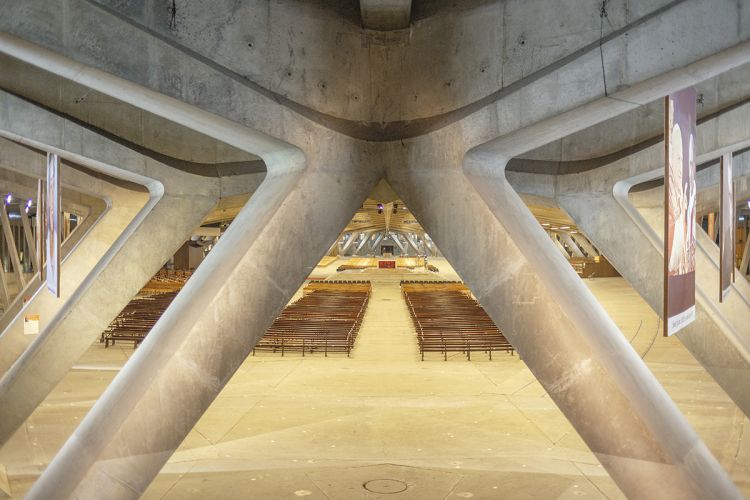

The Basilica Saint Pie X has closed for the first time since its inauguration in 1958 on the 100th anniversary of the apparitions of Our Lady to Bernadette. It has a capacity of 20,000 people and was built to accommodate the crowd.
It will reopen its doors to celebrate the international mass of the military pilgrimage on 23.05.21. -
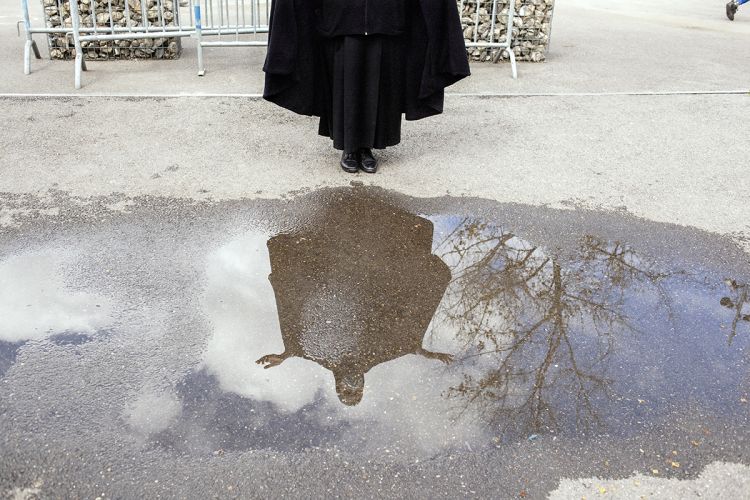

This crisis highlights the question of death, every day we have found ourselves confronted with our dead in all countries in the world and at the same time many people were deprived of their relatives’ death. There was a paradox between the omnipresence of death and death deprivation. Death is legitimately frightening but for believers, it means the transition to God. The Virgin said to Bernadette: “I do not promise you happiness in this world but in the ´next´, Lourdes is regarded as a place of hope. In response to the political vacuum during the pandemic, many people felt the need to get closer to the spiritual. The shrine must rethink its accessibility: the pilgrim is not only a physically ill person, but also a person who suffers psychologically or who simply needs air, magic, harmony.
-
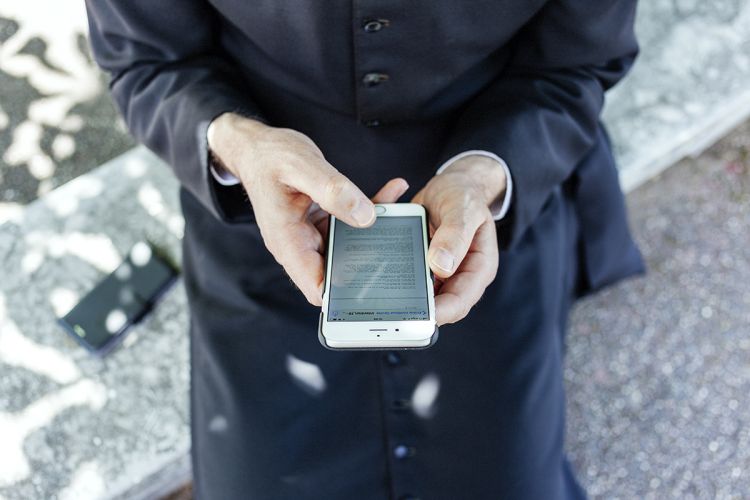

Father Pascal reviews the prayer intentions received by all the fathers working in Lourdes. On May 19, 272 pages containing 2000 intentions were received.
An estimated 600,000 digital prayer intentions were received since the beginning of the pandemic from all continents, in different languages. All these individual prayers were then delivered to Our Lady on the Grotta in an uninterrupted prayer in March 2020. Can we imagine that the pandemic led to a rebirth of faith? -
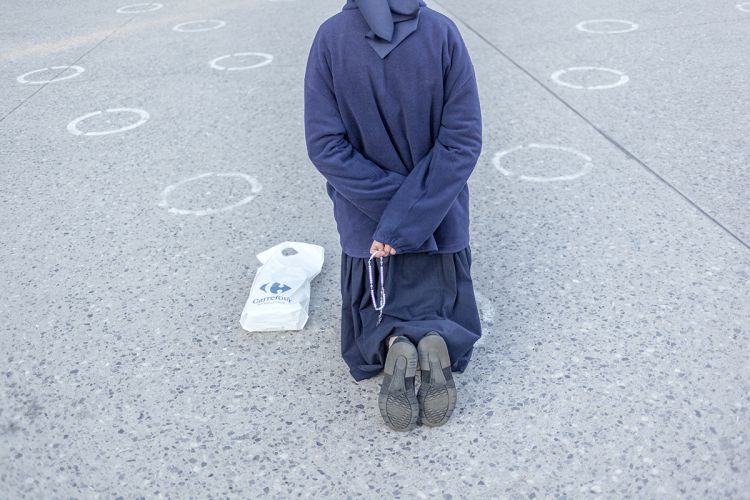

-
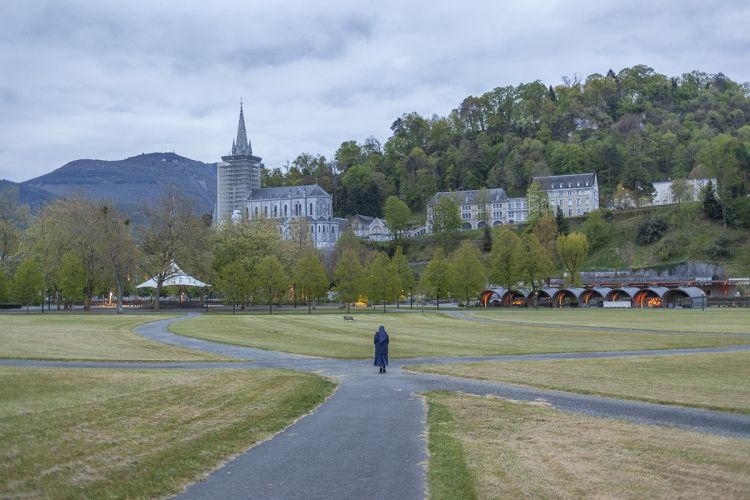

Sister Margarita goes to the grotto to prepare the Eucharist. 16th April 2021. A nun prays in the grotto from the anti-covid distancing sign. “Although it may not be, many see these times as apocalyptic. However at times like these, when anxiety and
fear are at their peak, people look for a refuge and faith becomes essential.”
It is with this in mind that those who are responsible for religious education see in this moment an opportunity to teach the faith. -
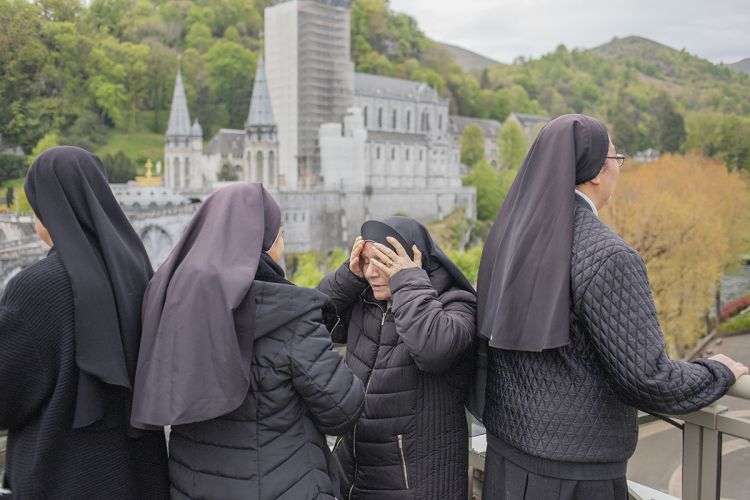

Portrait of the Daughters of the Immaculate Virgin of Lourdes, the “Immaculatines” is a Fran- ciscan religious community established in Lourdes since 2008. They participate actively in the economy of the sanctuary and in the spreading of the message of Lourdes.
Sr. Cecilia is an employee, working at the information point.Sr. Marta is in charge of the liturgical sewing room. She is currently unemployed.
Marta Elizabeth works in the Mass office where Mass intentions are purchased. Since the pandemic she is technically unemployed as the purchase of masses and intentions is now generally done through the internet. Cherubine, arranging her headdress, devotes her time to prayer. -
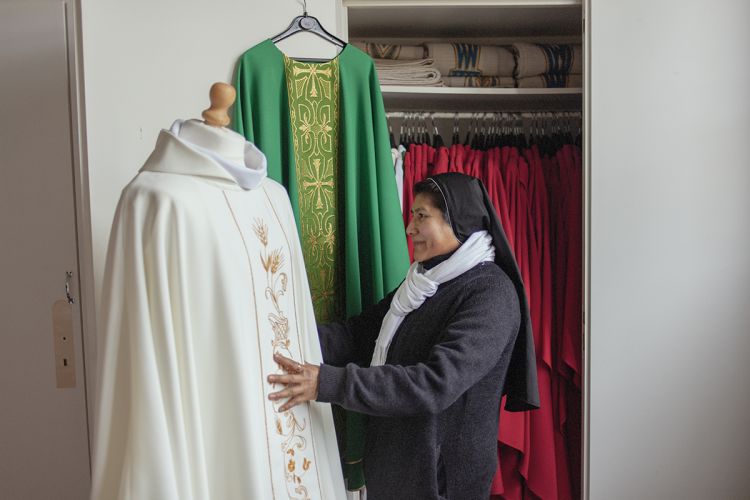

Portrait of Sister Marta in the Ouvroir – A place where a women community or a convent meets mainly for needlework. The Ouvroir has been closed since the beginning of the pandemic. Sister Marta, who was technically unemployed, went through this period with difficulty. She concentrates on continuing to connect and weave, through prayer from a distance, the social thread with the 20 volunteers coming from different horizons to help her on a regular basis.There are 240 employees, 80 seasonal workers and a strong network of volunteers at the Shrine. In 2020, 80% of the employees were technically unemployed and no seasonal workers hired.
-
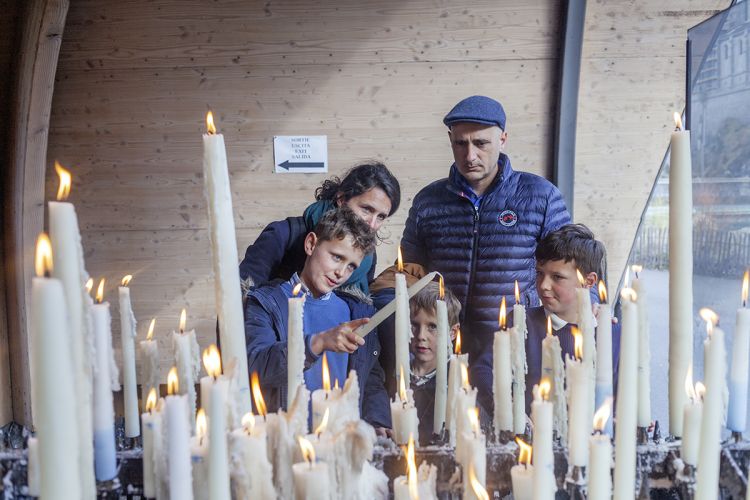

The Autric family places a candle to ask for the recovery of Arnaud, the father familly waiting for a bone marrow transplant.
For them, the pandemic has no special importance. The leukaemia drove them to come at this particular time despite the prohibition to move by the government. “Lourdes represents a closeness to the heart of Mary, to come and meditate here will amplify our call for healing. Lourdes is lived at home but also here, near Mary, we like to imagine that our prayer intentions will be fulfilled,”. -
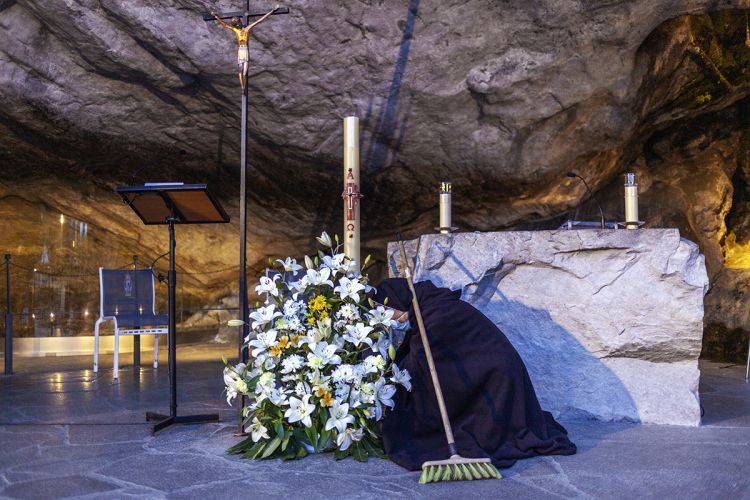

In collaboration with the “feutiers”, Sister Cecilia prepares the Eucharistic celebration for the Mass in French at 08am. Sister Cecilia feels a special maternal presence of the priests towards the world by digitalising and setting up continuous masses. During the confinement, supporting the priests became her priority.
-
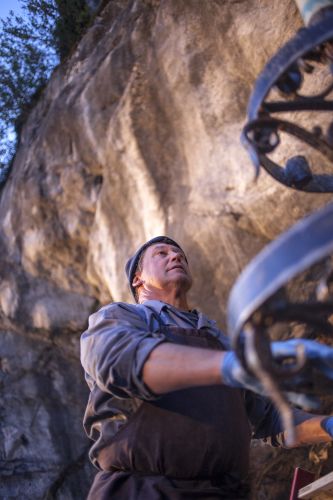

Patrick Guiraud prepares the candelabra which, with its 95 candles, is at the foot of Mary. The ten fire-keepers have the task of maintaining the thousands of candles placed in the Marian city, but also of accompanying the pilgrims on their journey. In normal times, no less than 1.4 million candles are burned at the shrine each year. Despite the Covid-19 pandemic, the service of the feutiers has been maintained. On one hand to enable the faithful to burn their candles from a distance, and on the other hand to maintain a continuous light in the grotto. If the periods of closure were obviously particular, this fire keeper points out that “between 400 and 500 candles have been lit every day since the last closure – a significant number – mainly thanks to the online purchase of candles”.
-
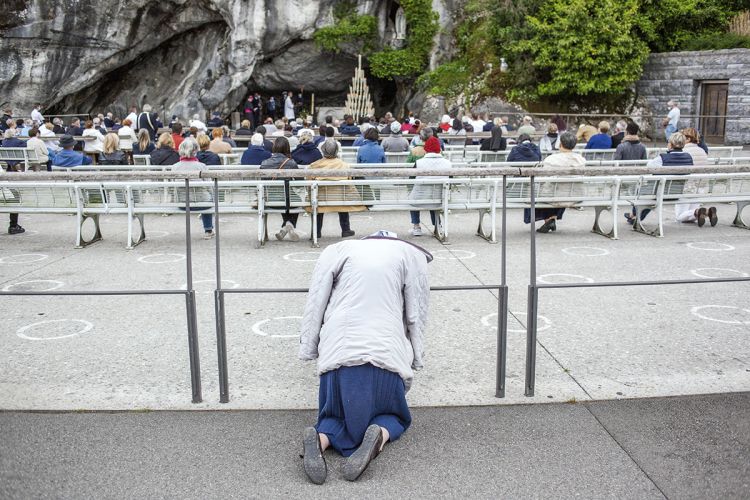

Rosary celebration at the cave of Lourdes a few days after the end of the lockdown in France.
-
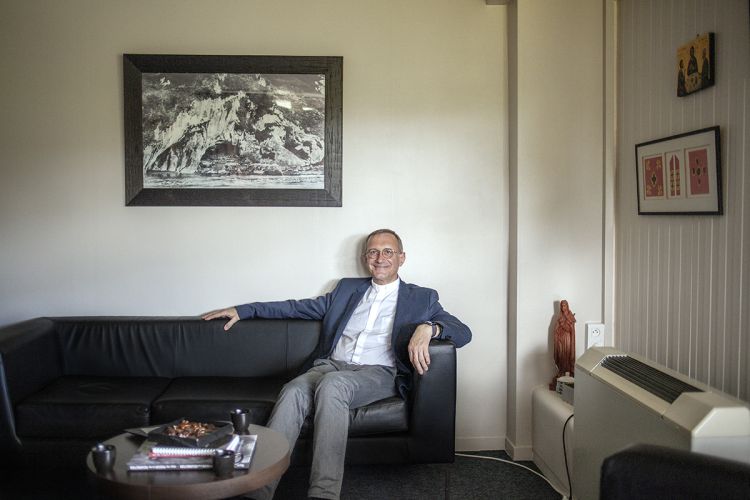

Monseigneur Olivier Ribadeau Dumas has been the rector of the shrine since 01.10.19.
He could never have imagined experiencing a crisis of such magnitude and finding himself obliged, a few months later, to close the sanctuary for two months. “This period is unprecedented, that of a deserted shrine with only one major concern: how to keep a space of grace alive when it is almost impossible to go there. Reinventing the radiation of Lourdes for the benefit of all the pilgrims but also for the non-believers who used to go there to meditate and reflect on themselves. In this ecosystem of Lourdes that includes the municipality, the ecclesiastical partners and the traders, the sanctuary must be profoundly convinced that it will drive the upturn of the city. The adaptability, reactivity, and creativity of the sanctuary have been very valuable for those who are there, but also for those who are not.”dixit the rector. -
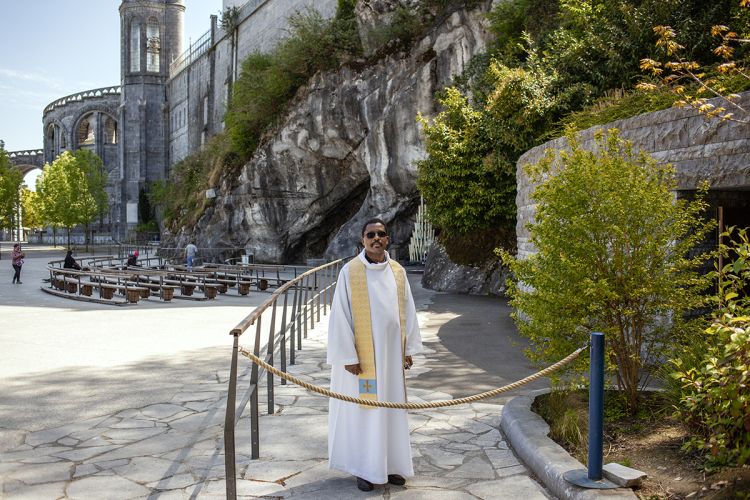

Father Max came from Benin to carry out his mission as confessor and chaplain in Lourdes. Between consecutive celebrations in the grotto and online su- pport to the faithful and pilgrims, an unusual routine was established during his confinement for Father Max, who longs for physical contact in the face of this mechanization of prayer. Right from the start and within the vacuum of physical space, online prayer however, was an opportunity to connect with the faithful who would never have come to Lourdes under other circumstances.
-
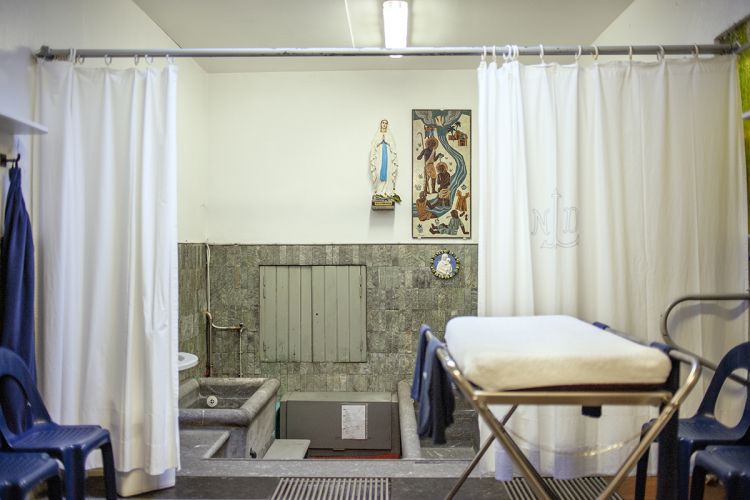

Inside the swimming pools of the Sanctuary.
-
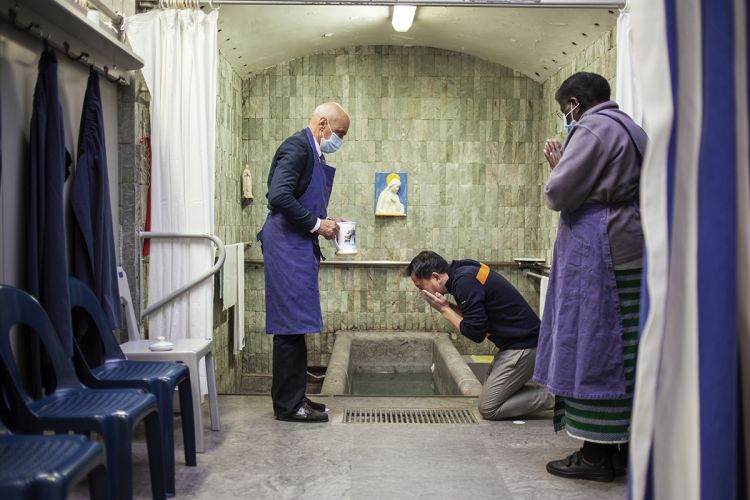

Access to the pools was rethought in response to Marie’s invitation to Bernadette to “go to the fountain to drink and wash” on 25.02.1858 with the creation of the water gesture which consists of pouring water into the hands of pilgrims so that they can drink and wash their faces. At no time did the Virgin say that she was going to bathe in the pools. With the pandemic, the sanctuary reinvented itself, returning to the original message of Lourdes, a message closely linked to prayer.
-
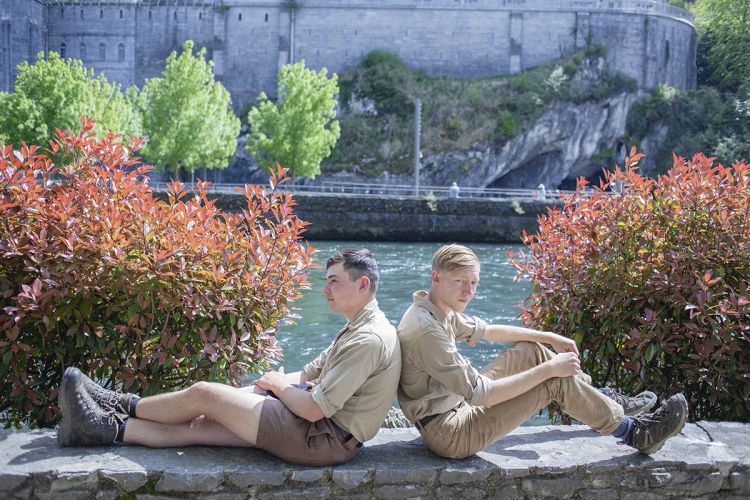

Louis and Gaston are originally from Mont Ventoux. They are walking from Biarritz to Toulouse, and passing through Lourdes, they deplore the state of the lower town with its closed shops, but admit to be enjoying themselves away from the overcrowded sanctuary and connecting spiritually with the symbolism of Lourdes in silence.
With the pandemic, the ones called in the sanctuary local slang “the hikers” become a greater source of interest to the rector aiming to turn them into pilgrims. Monseigneur Olivier Ribadeau Dumas, rector of the shrine, says “We need a larger inclusion of the type of people we welcome. My responsibility, within this epoch marked by a de-Christianization of our country and our society, is to envision what’s necessary.It poses the question of the Sanctuary accessibility and the religion for non-believers. The objective is to put aside the dichotomy between pilgrims, visitors or tourists. It is an opportunity, a gateway to discover the cultural heritage of Lourdes. -
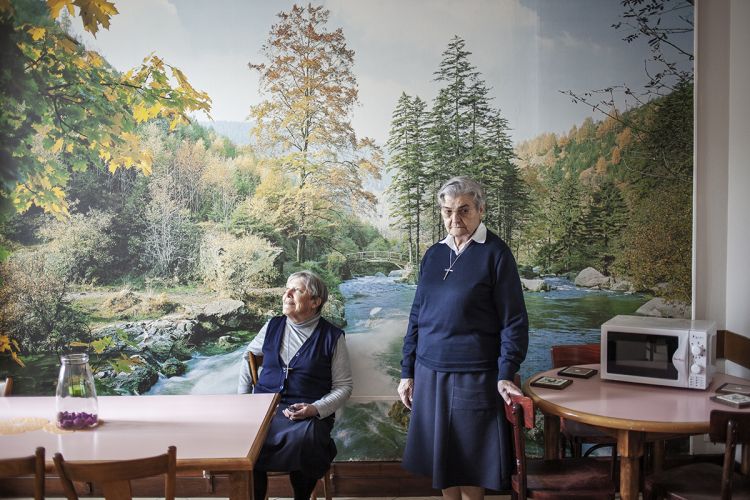

Sister Marie Noelle and Sister Carmen pose in the empty refectory of the Little Convent. Half convent, half hotel, this place also welcomes individual pilgrims and offers them a mystical experience for two to three days. During the pandemic, the Sisters of the Immaculate Conception of Lourdes who symbolize the influence of Lourdes on the international scene are far from their original mission. Remote prayer, theological training, spirituality and online assistance to the most vulnerable are now part of their daily routine.
-
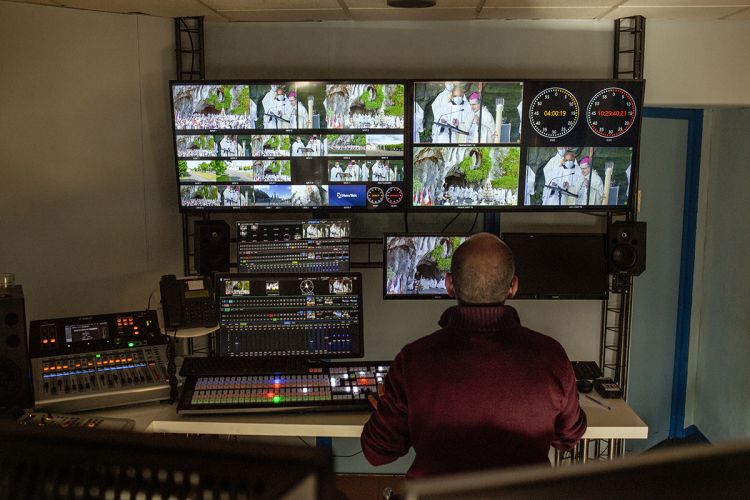

Behind the scenes of the Shrine’s television during the broadcast of the international military pilgrimage’s opening Mass.
The broadcasting began with the historic closure of the Shrine on 2020. The acquisition of technological and audio-visual equipment to facilitate the daily broadcasting of the masses and celebrations from the grotta to television channels was the major investment of the Sanctuary during the pandemic. Since 2008, the studio of “TV Lourdes”, the Shrine’s television channel and web TV, has been located in the premises of “Radio Présence”, in the Rue du Sacré-Cœur, in the town of Lourdes. Every day, “TV Lourdes”, thanks to 14 cameras installed at the four corners of the Sanctuary, broadcasts all the masses, the religious processions, but also a live broadcast from the Grotto, 24 hours a day.
This period is unprecedented, that of a deserted shrine with only one major concern: how to keep a space of grace alive when it is almost impossible to go there. -
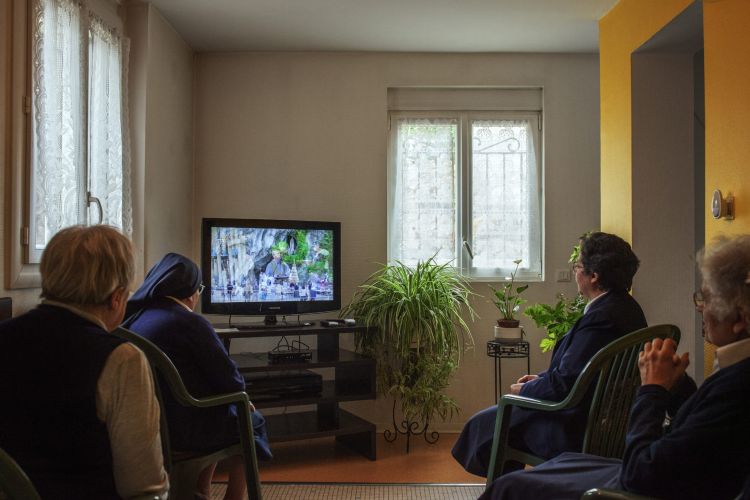

The nuns of the Petit Couvent pray the chaplet from their lounge.
-
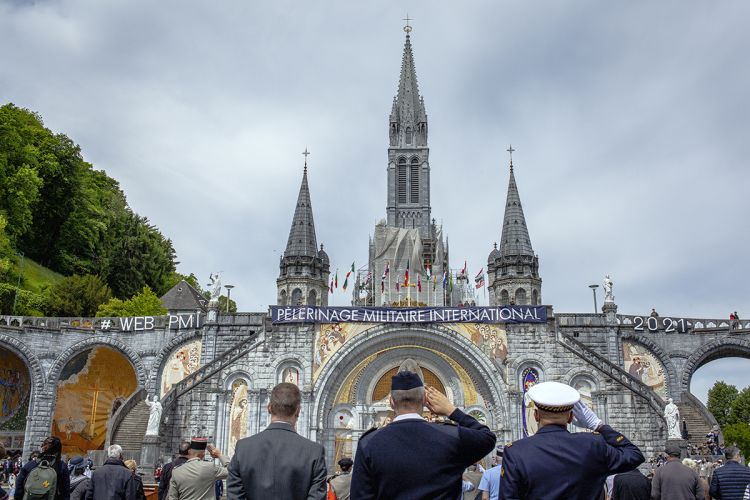

Ceremonial drills at the end of the mass on the esplanade of the Rosary. In 2020 the PMI was cancelled. This year there was the will to be physically present in Lourdes in order to keep close with the pilgrims since the establishment of the web-pilgrimage or “pilgrimage in spirit”. The PMI 2021, acting as the first pilgrimage of the year and overlapping the weekend of the end of the lockdown in France, was maintained this year with a reduced number of people and very few “visible” sick people. 475 military personnel were present in Lourdes, including 12 Defense Attachés representing 12 nations. On the networks, the youtube audience of the PMI was 68,500 views.
-
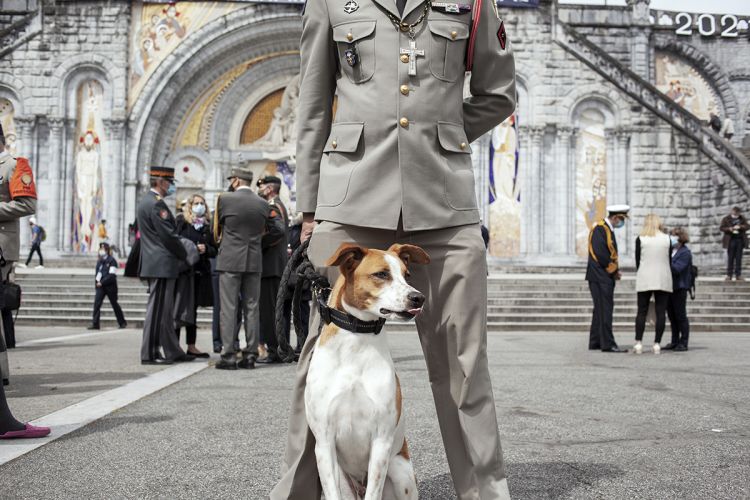

Photograph of Nougat, the first dog to have been authorized to enter the sanctuary to attend the ceremonial drills during this exceptional military pilgrimage international (PMI). This first Web PMI produced technical innovations such as the creation of a # that speaks to young people. A pilgrimage with small attendance at a face-to-face level but very important remotely, got modernized. In 2020 the PMI was cancelled. This year there was the will to be physically present in Lourdes in order to keep close with the pilgrims since the establishment of the web-pilgrimage or “pilgrimage in spirit”.
-
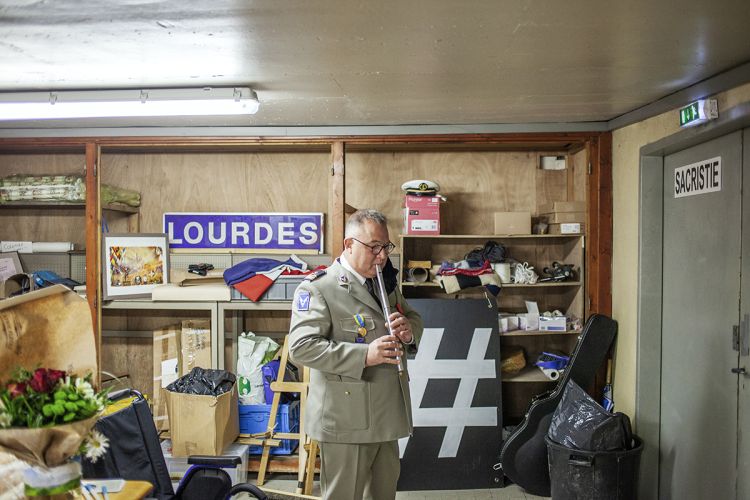

-
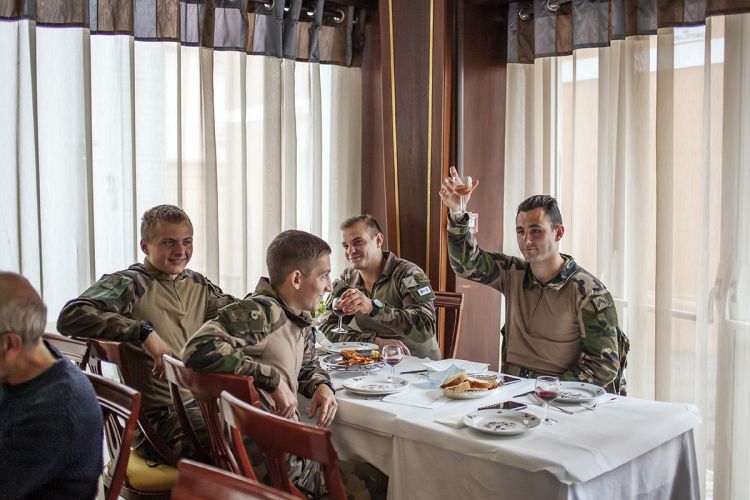

Farewell lunch for the PMI technical team at the Hotel d’Irlande. A toast was raised in honor of the work of these young soldiers of the 35th RAP (paratroopers) in setting up the PMI.
Isabelle Didelin, owner of this small family-run hotel, opened its doors exclusively for the PMI team 10 days ago.In 2020, the hotel opened for only 3 weeks. This year, she received the confirmation of about 10 regular customers for the 4th of July. To ensure the safety of her customers, she turned to the expensive Covid Safe audit. However she does not count on the presence of the hospital guests who normally stay there. Looking at the overcapacity of the hotel industry and the lack of synergy between the main players in the city, Isabelle also wonders how to motivate her customers to come back to Lourdes after not being able to come for two years. “With the digitalization of Lourdes, there is also the risk that the most vulnerable get used to living the experience online, just as we got used not to travel during the pandemic.”
-
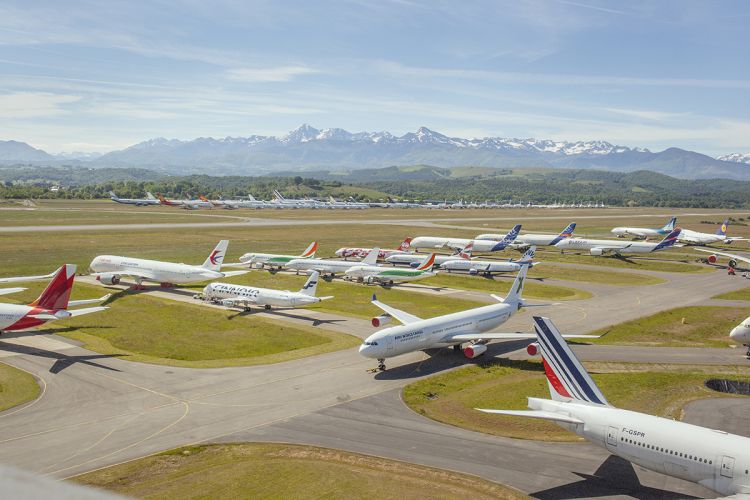

At the foot of the snow-capped Pyrenees, dozens of aircraft from all over the world are carefully lined up like toys in a giant car park. Since the Covid-19 crisis, Tarmac Aerosave has been overwhelmed by requests for storage from airlines.
Tarmac Aerosave currently shelters around 230 aircrafts on its four sites, instead of 150 in 2019. Lourdes is thought of and experienced at an international level; with this in mind it is difficult to imagine a new influx of pilgrims. -
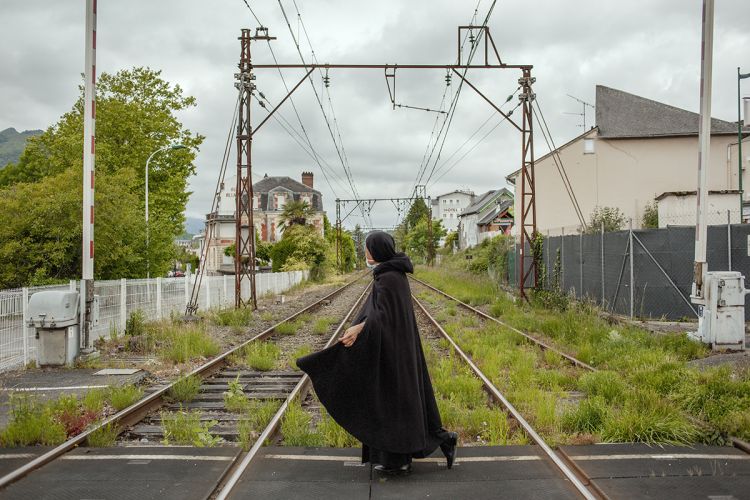

The decline of Lourdes as a town began before this health crisis. It started in 2011 when President of the SNCF Guillaume Pepy removed all ambulance trains, special trains for pilgrims, from different parts of Europe. The difficult accessibility of Lourdes started to affect the economy. About 700 pilgrim trains, i.e. 210,000 people, come to Lourdes every year, more than half of them coming from abroad (Italy, Belgium, Germany). In 2016, with the final removal of the night trains, the tradition of travelling by train to Lourdes, which had been ongoing for a century and a half, was ended, leaving many consequences for commercial, hotel and religious activities.
-
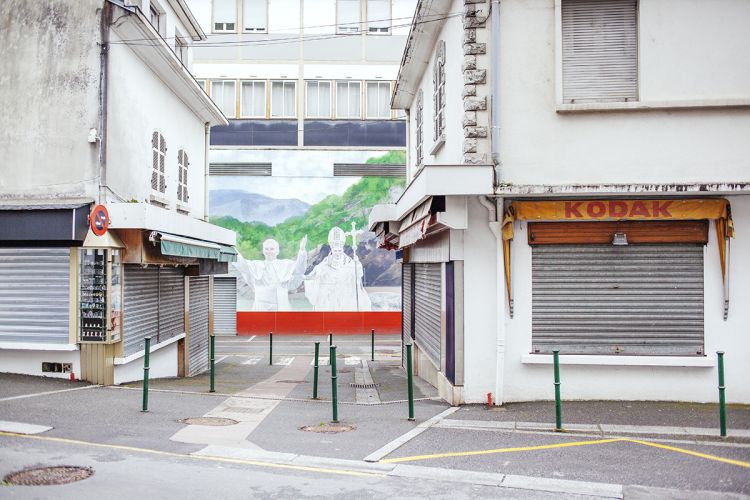

The avenue Mgr Schoepfer is deserted.
Shopkeepers whose stores remain closed can only hope for an improvement in tourism and healthcare while continuing to doubt their financial future. When people passing by are tourists and not pilgrims, surviving the crisis is almost a miracle.
To enhance a new image of Lourdes’ brand as a four seasons destination for tourism has become a vital priority. -
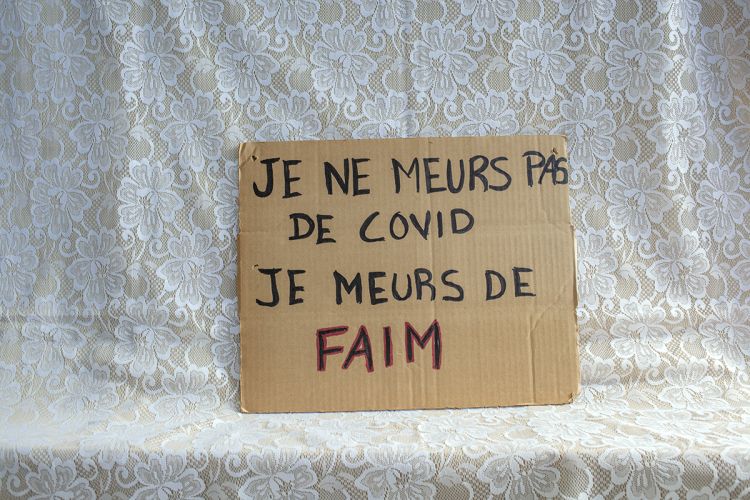

Sign edited by the Lourdes and Valley seasonal workers’ association for a demonstration in defense of the seasonal workers who find themselves in extreme precarity after a season without working because of the pandemic. The seasonal workers decided to send a letter to the Prime Minister asking for com- pensation for a “blank year”: “We have estimated the amount of 1,000 euros per month, i.e. 12,000 euros, it is a low average but we want it”. Photo taken at the food counter, a shop located at 12 rue Alexandre, which opened its doors during the pande- mic to help the families of highly vulnerable seasonal workers. Figures: some 2,344 seasonal workers keep the Marian city alive.
-
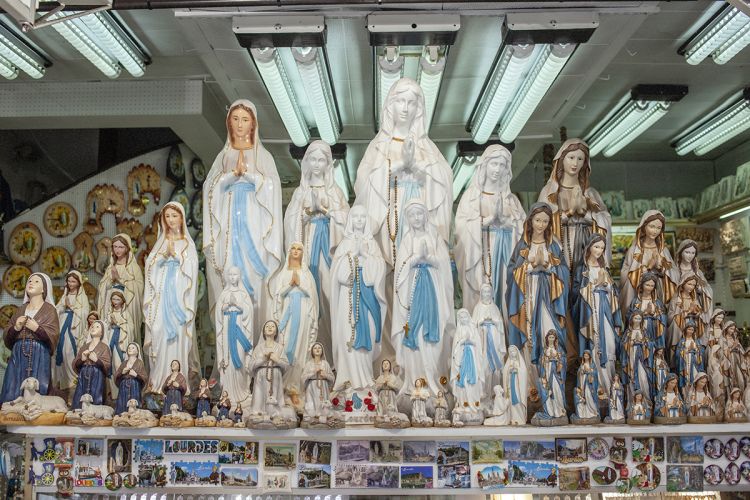

In the heart of the city’s iconic shops, nicknamed “the banks of the cave”, candles, rosaries and virgen filled with holy water abound. This year, only the pilgrim is missing. The Saint Benoît store closed its doors from April 3rd to May 19th 2021. An almost “symbolic” reopening. Since October, government support has helped to cover the fixed costs and allowed this shopkeeper to avoid bankruptcy.
-
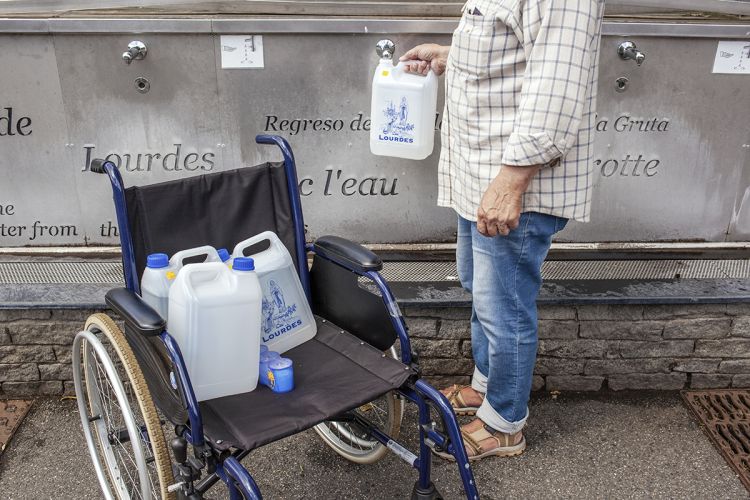

A pilgrim refills his jugs. He says he always mixes a few drops of Lourdes ́s water with his tap water to make it cleaner.
In Lourdes, water is essential. The problem of the accessibility to the sources without contact was raised. Hence, an important budget was allocated to the implementation of water fountains with automatic detection. -
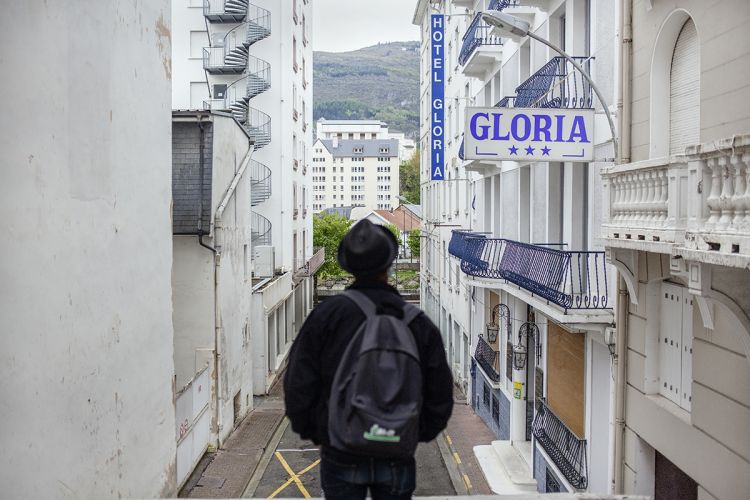

Aziz arrived in Lourdes from Italy on May 12th 2000. At that time, the Marian city was a source of income for seasonal workers. He started as a cook in different hotels in town before buying a bar in mana- gement three years ago, which he opened temporarily during the pilgrimage season at the sanctuary. At the beginning of the pandemic, he had to close down as he was unable to cover the costs and began a bankruptcy proceeding. I met Aziz sleeping under the porch of the Hotel Compostelle.
-
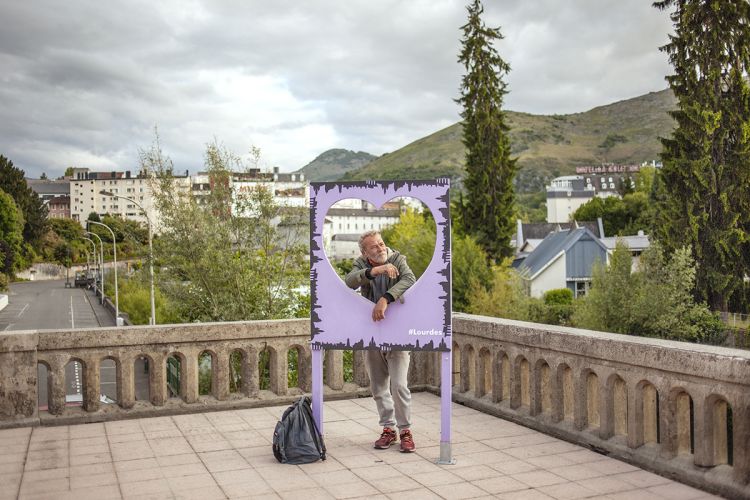

After separating from his girlfriend, Thibaut landed in Lourdes in October 2020. He lives on the street under the porch of the bar La source, which has been closed since the pandemic began. He likes to sit at the entrance of the sanctuary in the evening. During the day, the police are instructed to kick out homeless people and beggars from the perimeter of the sanctuary.
There is an urban photocall installed there by the outgoing city council of Josette Bourdieu. Several are scatte- red around the city, all oriented towards the “holy” statue of Saint Bernadette or towards the sanctuary.
With the new city council, the # becomes #LourdesAutrement and tends to affirm its commitment to change the exclusively spiritual outlook of the Marian city. -
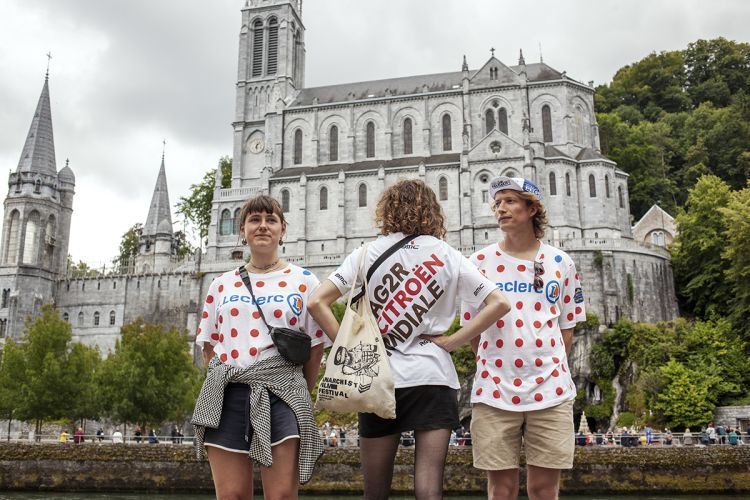

Boeke, Simon and Lottie are posing in the sanctuary. They set off two weeks ago by car from Amsterdam to follow all the stages of the Tour de France and discover the country. The eighteenth stage of the Tour de France passes through the Marian city and the “excursionists” take advantage of the event to visit the sanctuary as a cultural heritage site, not for any religious interest.
-
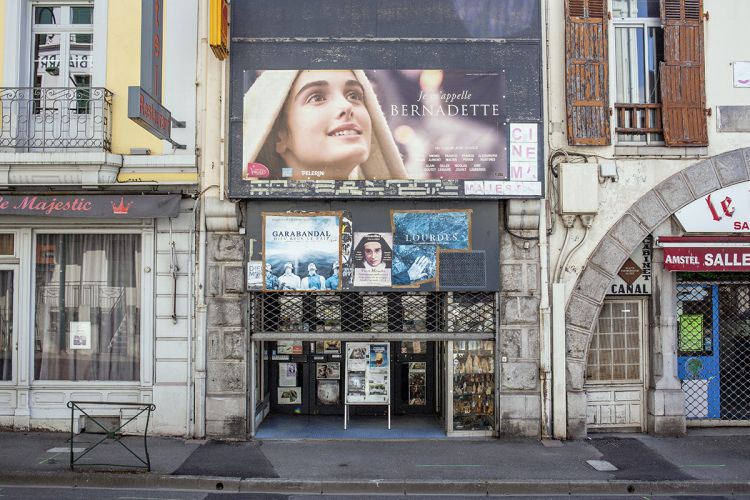

The shutters of the Majestic cinema are half-open despite the closure of all cultural venues since the second lockdown. At the window we find the owner, Roland Rambeau, in the middle of administrative paperwork.
-
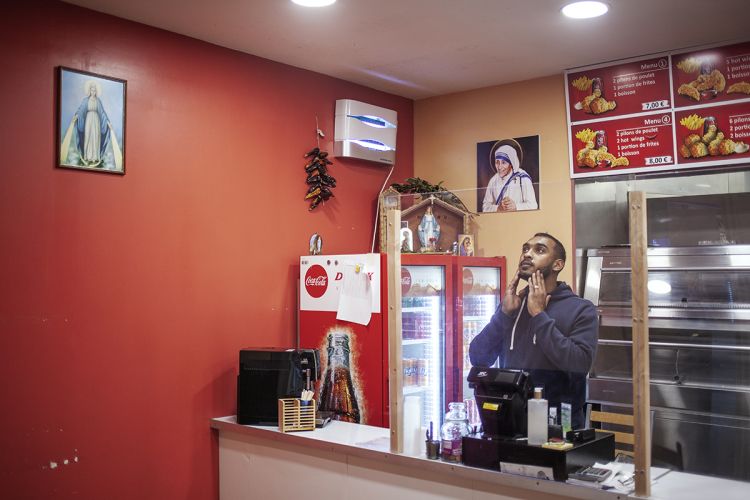

The AFC Chicken shop is the only restaurant on the boulevard de la grotte that remains open continuously throughout 2020 and 2021. With a drastically reduced menu, the family Thevapalan from Sri Lanka who settled in Lourdes 5 years ago to be closer to the Sanctuary decided to continue working to feed the few pilgrims visiting the city. “When the Sri Lankan Hindus arrived in France, but also in the rest of Europe, they had no temples to pray. So they found in the Virgin Mary the equivalent of the Tamil goddess Mariamman”, Nadarajah tells me. That would explain, according to him, the strong anchoring of the Tamoul community in Lourdes.
-
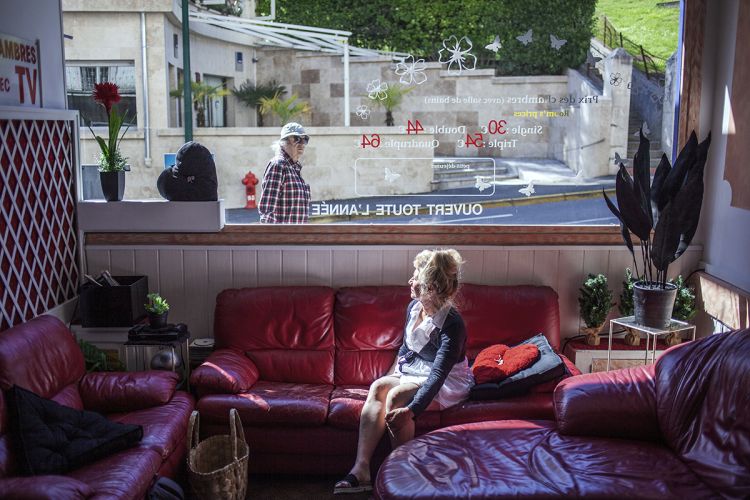

On the boulevard de la Grotte, the hotel Le Chalet Saint Louis was the only one to remain open throughout the year despite the pandemic. Veronique, originally from Paris and owner of the hotel, settled in Lourdes at the age of 50 after living a nomad life for many years in her campervan. Her decision to reconsider her life here, anchored to the land and the territory, is due to the fact that her father came here at the age of 14 to be cured from paralysis and got cured. In 2020 she received 40% less visitors than in 2019, but she still decided to open in 2021 for the few individual pilgrims visiting Lourdes and to offer them the possibility to re- cover. At the same time, during the pandemic, she began to accommodate people in need at a symbolic price. Far from being pessimistic, Veronica understands the challenge of rethinking the city from the individual and not from the collective, seeing almost all the pilgrimages cancelled for 2020.
-
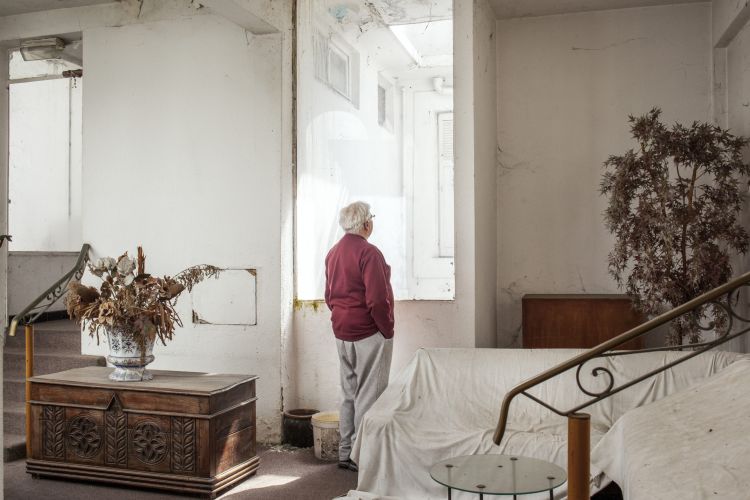

M. Alain Vargès in his two-star hotel le Saint Martin. As a third-generation hotelier, he decided to close the hotel for good 15 years ago as he could no longer afford the major costs of the ERP reno- vation, of the security and fire requirements. Facing an increasingly strong competition with the emergence of high-quality hotels partnering directly with dioceses and tour operators and more and more demanding customers, this family-run guesthouse preferred to remain still and stop the flow of time. For him, Lourdes has been the city of hope since 1858 and he does not despair of being able one day to pass his keys, his inheritance and his memories to the hands of others.
-
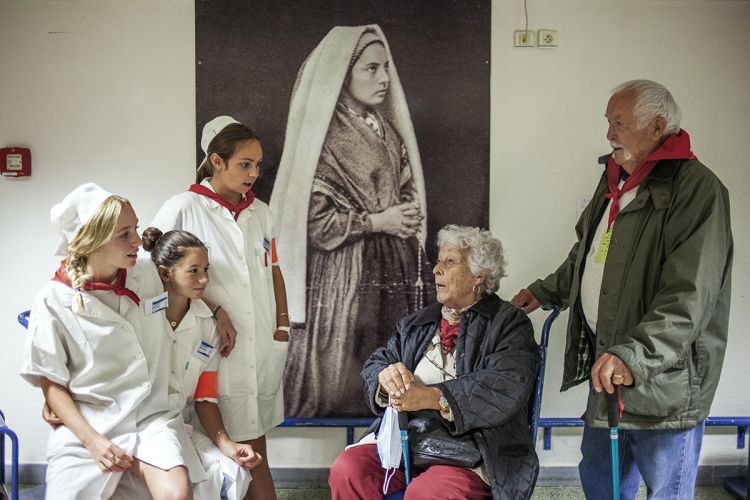

Mr and Mrs Hervé have been taking part in the Montpellier diocese pilgrimage for many years. They talk with the young Hospitallers in front of the portrait of Saint Ber- nadette. Mme Hervé said that her granddaughter was also a Hospitaller but had decided not to participate this year. A loss of interest caused, according to them, by her atheist boyfriend. One of the girls told them that her parents, like many others in the Saint-Roch Hospitality, met here in Lourdes when they were Hospitallers. This scenario raises questions for me about the decline of religion from intergenerational transmission.
-
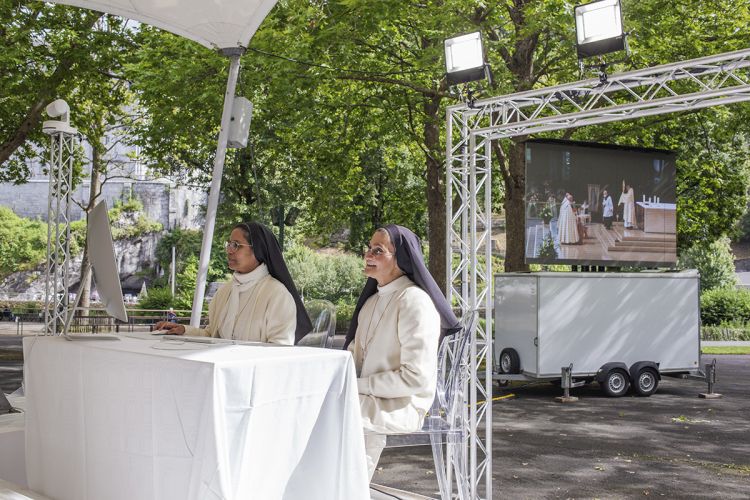

Sister Fidenza from India and Sister Constantine from the Philippines, from the community of the Daughters of Leuca, responded live to the prayer intentions entrusted by Asian pilgrims through social media on the Lourdes United TV set.
Lourdes United, the second edition of the global digital pilgrimage, gathered tens of millions of people from all over the world around the Lourdes Grotto. -
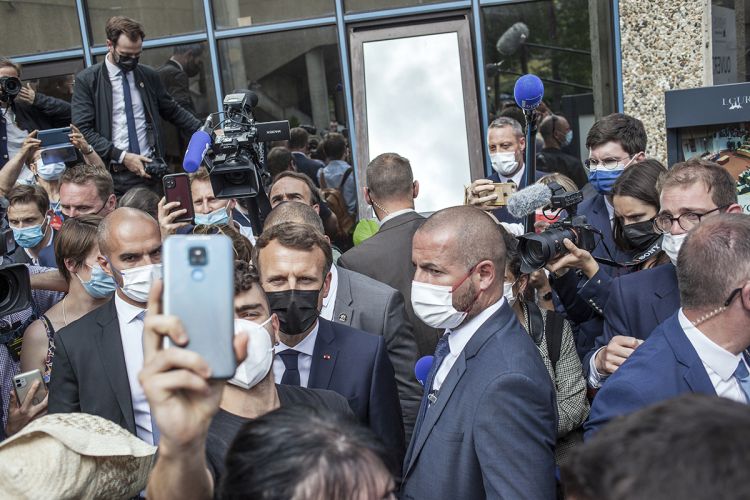

A crowd and selfies for President Emmanuel Macron, who will be the first president of the Fifth Republic to visit the shrine of Lourdes. The economic visit coincides with the second edition of “Lourdes Uni- ted” and promotes the economic recovery of the Marian city, the French city most affected by the health crisis. It is also a visit with a political dimension to try to seduce the Christian electorate.
16 July 2021. Hospitallers from the Saint-Roch Hospitality of the Diocese of Montpellier attend President Macron’s visit to the Shrine on the day when, according to believers, the 18th and last apparition of the Virgin Mary to Bernadette Soubirous took place in the cave of Massabielle.
The “Accueil Notre-Dame”, a medical structure located in the heart of the Sanctuary, which usually receives sick or frail people wishing to make a pilgrimage to the city of the Virgin Mary, has been transformed during the pandemic into a shelter for Covid-19 patients in a precarious situation.A brief incident occurred during the walkabout. As he began to meet pilgrims, one man shouted “shame on you, Macron” and “you’re a primitive atheist” before being quickly challenged.
-
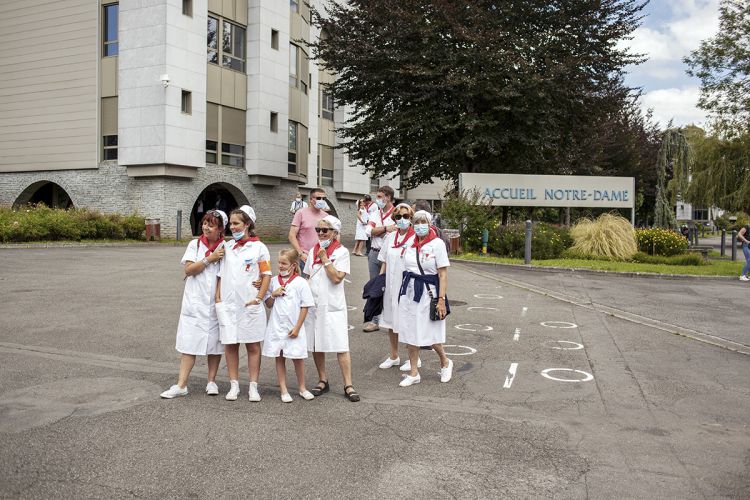

Hospitallers from the Saint-Roch Hospitality of the Diocese of Montpellier attend President Macron’s visit to the Shrine on the day when, according to believers, the 18th and last apparition of the Virgin Mary to Bernadette Soubirous took place in the cave of Massabielle.
The “Accueil Notre-Dame”, a medical structure located in the heart of the Sanctuary, which usually receives sick or frail people wishing to make a pilgrimage to the city of the Virgin Mary, has been transformed during the pandemic into a shelter for Covid-19 patients in a precarious situation. -
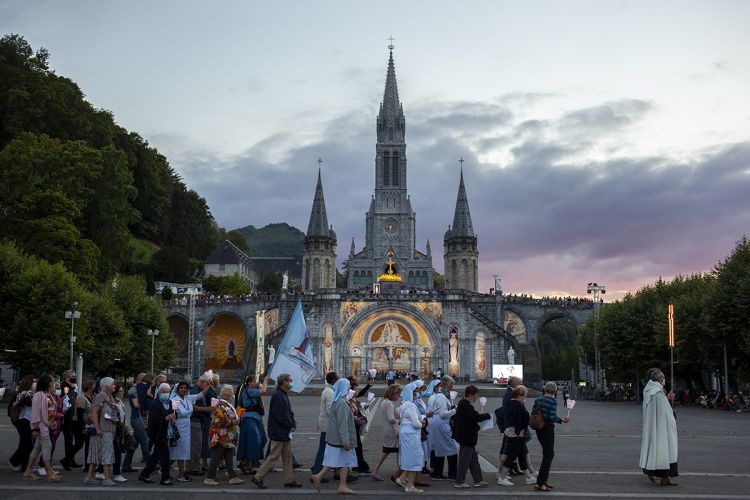

The Sanctuary, the municipality and the traders have formed an unprecedented alliance with the aim of achieving, through solidarity and in the long term, a real renewal of the image of Lourdes, so that believers and non-believers alike can find their place.
-
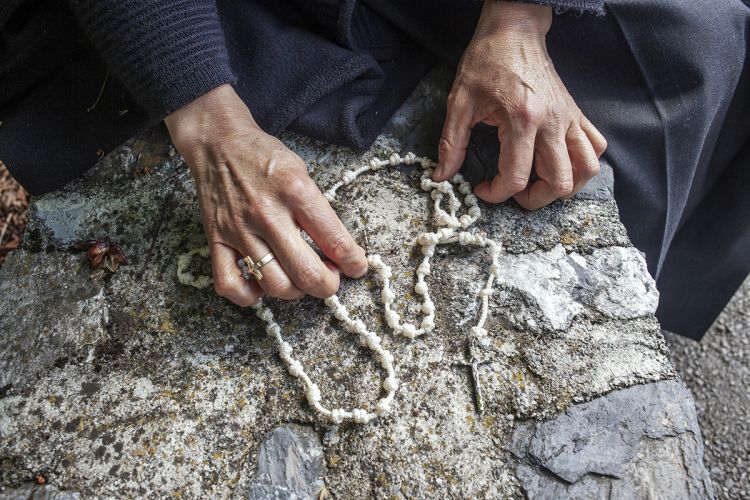

Sister Cecilia gives me her handmade rosary. Far from being overcrowded with people, this place becomes an opportunity to replenish spirit. I learn to distance myself from my own prejudices in order to reconsider my position on faith. Beyond the sanctuary, I claim my territory.
-
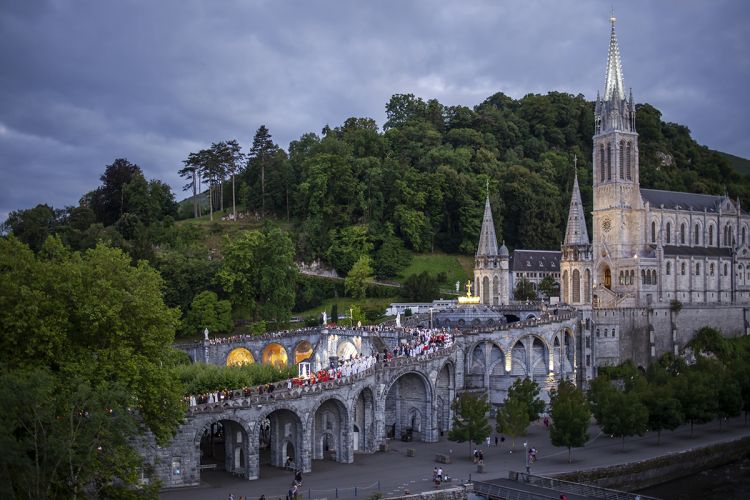

Several spiritual highlights are planned around Lourdes United, the second edition of the world e-pilgrimage, such as the torchlight procession, an essential part of a pilgrimage to Lourdes, and the inauguration of the renovated bell tower of the Basilica of the Immaculate Conception.In July,Lourdes started to be reactivated with a label “Estivales”,offering numerous events and activities to attract tourists to the city of Lourdes throughout the summer.
2021, Lourdes, France
Publications
Revista 21 nº1058
Luzes Magazine, Nº96
Lourdes United
The Shrine of Our Lady of Lourdes, a major Catholic pilgrimage site, experienced a 95 per cent drop in visitors during 2020, leaving it empty even on its most important celebration days. Faced with the shrine’s first historic closure, its leadership launched “Lourdes United” in July 2020, the world’s first electronic pilgrimage, broadcasted in 10 languages and reaching 80 millions people. Lourdes United documents how the shrine is reinventing itself to stay connected to its faithful, and what this change may mean economically for the surrounding town, second largest hotel city in France after Paris with 4,000 of its 13,000 inhabitants unemployed.
Project supported by COVID-19 Emergency Fund for Journalists from National Geographic Society.